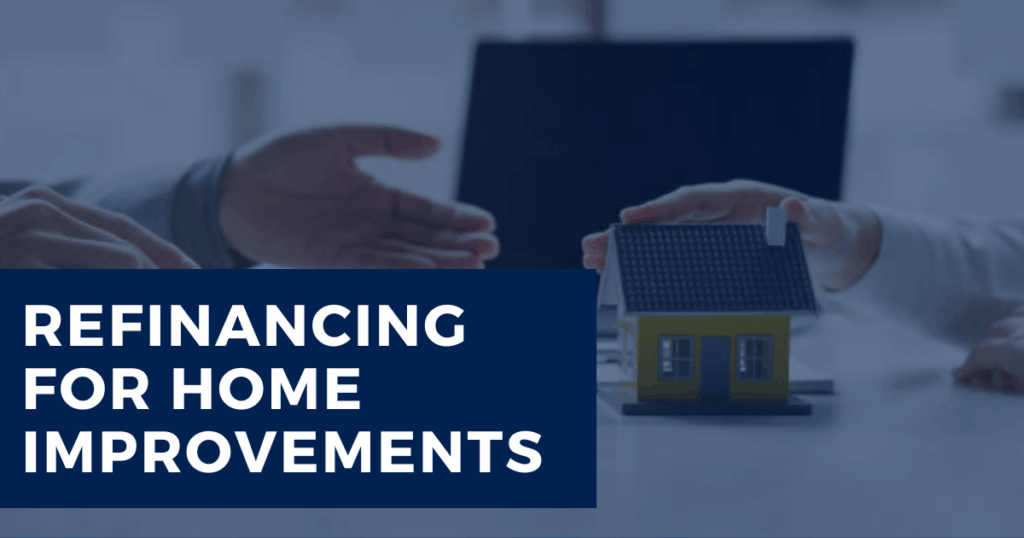
Thinking about finally tackling that kitchen remodel, bathroom upgrade, or dream backyard deck? Renovations can make your home more comfortable and even boost its value. But the cost is often the biggest hurdle. One option many homeowners explore is refinancing their mortgage to help pay for improvements.
Refinancing may sound complicated, but with the right information, it can be a practical way to fund projects without draining your savings. And with home improvement spending expected to shift in the coming years, knowing your options is more important than ever.
How Does Refinancing for Home Improvements Work?
When you refinance, you replace your current mortgage with a new one, often with different terms. For home improvements, two main types of refinancing are common:
- Cash-Out Refinance – Borrow more than your current loan balance and take the difference in cash for projects.
- Rate-and-Term Refinance – Adjust your rate, loan term, or both to lower monthly payments and free up money for renovations.
The right choice depends on your financial situation, project size, and long-term goals.
Cash-Out Refinance: How to Tap Into Your Home Equity
A cash-out refinance allows you to access your home equity and turn it into cash for bigger projects. For example, if your home is worth $400,000 and you owe $250,000, you may be able to refinance into a $300,000 loan — using the $50,000 difference to fund renovations.
Qualifying for a Cash-Out Refinance
Lenders look at several factors when approving cash-out refinances:
| Factor | Description | Typical Requirement |
|---|---|---|
| Credit Score | A number reflecting your creditworthiness. | Often 680 or higher |
| DTI | The percentage of your monthly gross income used for debt payments. | Typically below 43% Sometimes up to 50% |
| Home Equity | The portion of your home you own. | Usually at least 20% |
| LTV | The ratio of your loan amount to your home’s value. | Generally 80% or lower |
These guidelines can vary by lender, so it’s always smart to compare options.
Rate-and-Term Refinance: Lowering Payments to Free Up Cash
Not every renovation needs a large lump sum. Sometimes, lowering your monthly mortgage payment is enough to free up cash for projects. With a rate-and-term refinance, you replace your current loan with one that has a lower interest rate or shorter term.
For example, reducing your interest rate by even 1% could save hundreds each month — money that can be redirected toward upgrades like new flooring or energy-efficient appliances.
Pros and Cons of Refinancing for Renovations
Pros
- Lower rates: Refinancing may reduce your interest rate, saving money over the life of the loan.
- Access to cash: Cash-out refinancing unlocks home equity for major projects.
- Possible tax benefits: Mortgage interest may be tax-deductible — check with a tax advisor.
Cons
- Closing costs: Refinancing comes with closing costs, which are the fees charged to set up your new loan — like the appraisal, title search, and lender fees. These typically add up to 2–5% of the loan amount, which for many homeowners means several thousand dollars upfront.
- Higher debt: Borrowing more increases your monthly obligation and overall debt load.
- Impact on DTI: A larger loan affects your debt-to-income ratio, which may limit future borrowing.
Alternatives to Refinancing
Refinancing isn’t the only option for funding home improvements. Depending on your project size and budget, you might consider:
Home Equity Loan
A home equity loan gives you a lump sum upfront with a fixed interest rate and predictable monthly payments. It’s best for homeowners who know exactly how much their renovation will cost (like a $40,000 kitchen remodel). Since the rate is fixed, your payments won’t change, making it easier to budget. On the downside, you start paying interest on the full amount right away, even if you don’t use all the funds immediately.
HELOC (Home Equity Line of Credit)
A HELOC works more like a credit card tied to your home equity. During the draw period (usually 5–10 years), you can borrow what you need, when you need it — only paying interest on the amount you’ve actually drawn. This flexibility makes HELOCs great for projects done in stages, like finishing a basement one year and updating bathrooms the next. The catch: most HELOCs have variable interest rates, so your payment can go up or down with the market.
Is the home equity or HELOC loan a better option for you? Read more about the two loans here.
Personal Loan
A personal loan is an unsecured loan (not backed by your home), which means the application is usually faster and doesn’t require home equity. It’s a good fit for smaller projects like replacing appliances or redoing flooring, especially if you don’t want to touch your mortgage. However, because it’s unsecured, interest rates are generally higher than mortgage-based products, and repayment terms are often shorter (3–7 years).
0% APR Credit Card
Some credit cards offer introductory 0% APR periods (often 12–18 months), which can make them useful for small, short-term expenses like buying materials or furniture. If you can pay off the balance before the intro period ends, it’s essentially an interest-free loan. But once that period expires, interest rates can jump dramatically, sometimes 20% or more, so this option requires discipline.
What This Means for Homeowners
Refinancing for home improvements can be a powerful tool, whether you’re planning a full remodel or simply looking to free up funds for updates. The key is to weigh the pros and cons, understand qualification requirements, and compare alternatives before moving forward.
With the right strategy, you can make your home more functional, comfortable, and valuable, all while managing your finances wisely. If you’re considering refinancing, Price Mortgage can help you explore your options and find the best fit for your goals.
Not Sure Where To Start?
That's okay. Let us build a custom loan program around your needs and budget.
Contact Us